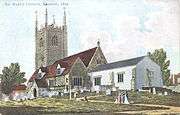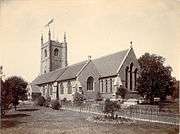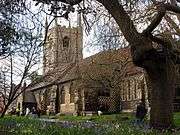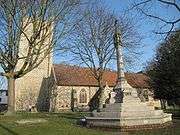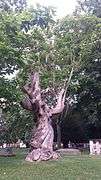Reading Minster
| Reading Minster | |
|---|---|
 The church tower, chequered with flint and stone | |
 Reading Minster Location within Reading Town Centre | |
| 51°27′16.2″N 0°58′25.0″W / 51.454500°N 0.973611°WCoordinates: 51°27′16.2″N 0°58′25.0″W / 51.454500°N 0.973611°W | |
| Location | Reading |
| Country | England |
| Denomination | Church of England |
| Website | readingminster.org.uk |
| History | |
| Founded | 7th century |
| Dedication | St Mary |
| Architecture | |
| Functional status | Active |
| Heritage designation | Grade I |
| Style | Gothic |
| Administration | |
| Archdeaconry | Berkshire |
| Diocese | Oxford |
Reading Minster, or the Minster Church of St Mary the Virgin as it is more properly known, is the oldest ecclesiastical foundation in the English town of Reading. Although eclipsed in importance by the later Reading Abbey, Reading Minster has regained its importance since the destruction of the Abbey and is now an Anglican parish church. It gives its name to the street of St Mary's Butts, on which it stands.[1]
The Minster Church of St Mary the Virgin should not be mistaken for the rather similarly named St Mary's Church, Castle Street, which is only a few yards away.
History
According to unverified tradition, Saint Birinus founded a small chapel on the site of Reading Minister in the 7th century. Silver coins of the 9th century have been found in the churchyard, dating back to the period when Kings Ethelred and Alfred of Wessex were fighting the Danes at Reading, and also the era in which Reading supplanted Calleva Atrebatum (Silchester) as the local centre of importance.[2]
In 979, Queen Ælfthryth, wife of King Edgar of England, founded a royal nunnery on the site as an act of repentance for the murder of her stepson, King Edward the Martyr. All that remains of this nunnery is a rounded Saxon door in the church, most likely used by the nuns to attend church services.[2]
In the 11th century, the Danes sacked Reading and the nunnery was destroyed. By the time of the Domesday Book, the church had been granted to Battle Abbey by William the Conqueror.[2]
In 1121, King Henry I founded Reading Abbey which grew to become one of the most important religious and political centres of England. For the following 400 years the Abbey was the centre of ecclesiastical power in the town, and the Abbot also held the post of Rector of St Mary's.[2]
The main body of the church dates from the late 11th Century, however in 1539, the Abbey was dissolved on the orders of King Henry VIII. In the Reformation that followed, St Mary's church was stripped of its altar, statues and stained glass, and by 1550 was in need of extensive repair. Between the years of 1551 and 1555 the church was extensively restored, using quantities of masonry and timber from the ruins of the Abbey. Contemporary accounts include payments for the dismantling and carriage of the Abbey's choir and nave roof, and is believed that the pillars which now separate the Minster's south aisle from the nave came from the Abbey.[1][2]
In 1918 a war memorial chapel, known as St Edwards Chapel, was added with entry through the old Saxon doorway of the nunnery. The church had undergone further restoration in 1863 when a new choir aisle was added, and in 1872; with further work in 1935 and 1997–2003.[2]
Bells
Most of the bells now hung in the Minster's tower date from the 17th and 18th centuries. The present peal consists of three dated 1640, two dated 1740 and two dated 1743. In 1611 the first clock was installed in the tower.[2]
Organ
The Minster's organ dates was built by Father Willis for the 1862 International Exhibition. It was rebuilt by the same company in 1936.[3] In the early 21st century, the church began a project to restore the organ. The organ was largely neglected throughout the 20th century, leaving pipes corroded, the bellows damaged and the soundboards warped.[4] The restoration requires a fund of approximately £500,000 and aims to replace the wind system, electronics and manuals.[4]
Churchyard
The churchyard extends to the south and east of the church, and is bounded by the streets of St Mary's Butts, Gun Street, Chain Street and by an unnamed footpath connecting St Mary's Butts and Chain Street along the rear building line of the buildings fronting Broad Street. It is crossed by several other paths which carry heavy pedestrian traffic between various town centre areas. The churchyard contains a number of significant trees, including a well-known 150-year old Indian Bean Tree (Catalpa bignonioides) that was thought, in 2007, to be unlikely to survive but has since sprouted new growth.[5]
Also to be found in the churchyard is the Jubilee Cross, built in 1887 to celebrate the Golden Jubilee of Queen Victoria. The monument is constructed in a 15th century style in Portland stone, and has a tapering octagonal shaft capped by a cross. It is listed as a grade II listed building. It has been suggested that it was constructed in reaction to the secular design of the nearby Jubilee Drinking Fountain that also celebrates the same anniversary and is located only a few feet away in the centre of St Mary's Butts.[6]
List of notable clergy
- Henry Hart Milman (1791–1868): 1818–35[7]
Gallery
|
References
- 1 2 "St Mary's Church". Reading History Trail. Retrieved 2009-04-30.
- 1 2 3 4 5 6 7 Leaflet History of Reading Minster, no stated publisher or publication date, available from the church
- ↑ "The organ in Reading Minster of St Mary The Virgin" (PDF). Reading Minster of St Mary The Virgin. Archived from the original (PDF) on August 7, 2008. Retrieved 2009-04-30.
- 1 2 Reading Minster (2011), 1862 Henry Willis Organ Restoration Fund [leaflet], Reading, Berkshire
- ↑ Fort, Linda (27 July 2015). "Trippy Tree in Reading Minster graveyard is refusing to die". getreading.co.uk. Trinity Mirror Southern. Retrieved 2 November 2016.
- ↑ "Jubilee Cross - Reading - England". britishlistedbuildings.co.uk. 14 December 1978. Retrieved 2 November 2016.
- ↑ Matthew, H. C. G. (September 2004). "Milman, Henry Hart (1791–1868)". Oxford Dictionary of National Biography. Oxford University Press. Retrieved 2009-04-30.
External links
| Wikimedia Commons has media related to Reading Minster. |
